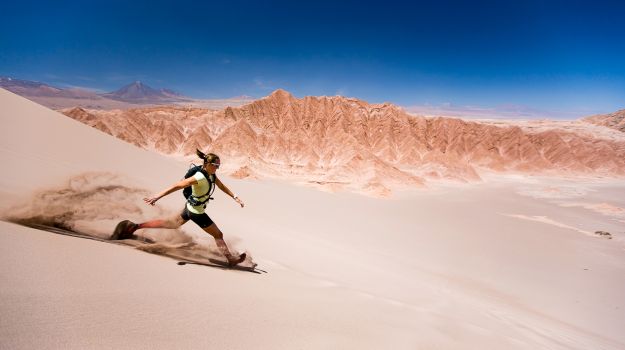 At age 35, Ervin is the oldest male swimmer on the U.S. team at the 2016 Olympic Games in Rio de Janeiro, competing in his third Olympics. He has racked up two gold medals at Rio, one in the 50-meter freestyle and one as part of the 4×100 freestyle relay team, racing in the prelims.
At age 35, Ervin is the oldest male swimmer on the U.S. team at the 2016 Olympic Games in Rio de Janeiro, competing in his third Olympics. He has racked up two gold medals at Rio, one in the 50-meter freestyle and one as part of the 4×100 freestyle relay team, racing in the prelims.
Koudele, 36, an endurance runner from Jackson Hole, Wyoming, is on pace to become the first woman to complete the Grand Slam Plus, a series of seven-day, 155-mile running events in extreme climates. Koudele was the female champion in Namibia and China and the second-place female racer in Sri Lanka. She heads to the Atacama Desert in Chile in early October and is on track to finish the series in Antarctica this November.
Both are competing at the highest levels in their respective sports, but both have burned out and quit their sport in the past. Yet they found their way back. How?
What most people think of as burnout – complete physical and emotional exhaustion – is really just the last and worst phase of burnout, says Keith Kaufman, a sports psychologist who teaches at Catholic University.
The first stage is a sense of staleness, where performance lacks crispness and energy. The second stage, overtraining, is where performance begins to plateau. Kaufman said there’s a fine line between being at peak performance and overtraining because it’s so easy for athletes to overdo it. The final stage of exhaustion and withdrawal is what Kaufman said is the endgame for burned-out athletes.
And once you start going down that road, it can be hard to stop. “You may see staleness, you might see overtraining, but you feel like you can’t stop. That’s where you see burnout really taking hold,” Kaufman said.
And it can affect anyone who specializes in one activity – even kids on sports teams. Studies in youth sports are showing that burnout increasingly can be found among younger athletes who compete in a high-intensity environment, already specialized in a single sport, without an offseason.
Motivation is key to understanding – and fighting – burnout. Kaufman describes motivation in two forms: intrinsic, where your motivation comes from within your own sense of doing well, and extrinsic, where outside incentives drive you.
Kaufman said today’s culture of sports drives intrinsic motivation out of athletes because instead of something being fun, it becomes a job.
As they get more specialized, athletes think, “‘Now, I’m going to get serious. … I have to get this scholarship or get this medal,’ and it becomes stress,” Kaufman said. “It becomes an obligatory task and chore, and that changes everything.”
Ervin won gold in the 50-meter freestyle at Sydney in 2000, then retired three years later at age 22. He had dreamed of the Olympics since his youth, and when he reached the top of his game, it forced him to question his reasons for continuing an all-consuming endeavor.
“Once I reached the summit … and after taking it in, I didn’t feel compelled to stay there,” he said.
Ervin climbed out of the pool and stayed out for years, taking on what he called a rock ‘n’ roll lifestyle and falling out of shape. He said he spent years looking for a sense of self outside of being a swimmer.
Koudele was a track star in high school but turned to triathlons after feeling burned out on running. Koudele came back to running years later because “I just missed running. It was so simple.” She took to road racing, but after tiring of roads, she pivoted toward trails, which led her to the Grand Slam Plus.
Koudele said she’s struggling with motivation in the midst of her quest to win the series. She runs two businesses and also is raising money for the LymeLight Foundation, which funds research to combat Lyme disease. She said she feels worn out, working to find the balance between competition and recovery.
“Somebody asked me what’s the hardest part about the Grand Slam Plus series, and I really do think that one of the hardest challenges – especially when you’re trying to win them all – is staying at that level of training, mentally, and staying at that level of fitness for a whole year,” she said.
The cure to burnout is simple yet incredibly hard: recovery and renewal.
Kaufman said part of the problem is that athletes (and people in general) tend to compartmentalize their stress: There is work stress and relationship stress and sports stress. Most don’t realize that stress is stress across the board.
“If you can’t carve space and can’t pause from the hamster wheel and commit yourself to some recovery or some balance in your life, then (burnout) is what is going to happen,” Kaufman said. He said that if you reach complete exhaustion, “your body will take the rest if you don’t give it to it.”
Koudele said changing up sports and changing goals helped her, as well as finding times within her training for renewal. While in San Francisco for a work meeting earlier this year, she needed to complete a 90-minute training session. As a child, she loved the Golden Gate Bridge, so she set her GPS device to cross the bridge as part of the session.
“And it was so fun because you forget about the fact that, ‘Oh my gosh, I had to run for 90 minutes when I’m really tired.’ Instead it was, ‘Oh, I’m going to do a fun project that I wanted to do since I was a kid.'”
Getting back to a childlike sense of intrinsic motivation is the key to protecting against burnout, Kaufman said.
With Ervin, seeing the kids he was coaching in Brooklyn embrace swimming is what brought him back into the pool. “I just wanted to recapture that playfulness of being in the water,” Ervin said.
In getting back into shape, Ervin said he felt he still could be competitive, and through some encouragement from the U.S. swim team coaches, he headed for the 2012 Olympic trials and made the team.
Now, four years later at Rio, Ervin is fully engaged, mentoring the younger swimmers and swimming with the right mind-set. When he asks himself, “Why am I doing this?” he can find gratification in simply being in the water. “I enjoy the labor in and of itself,” he said.
[“source-ndtv”]










